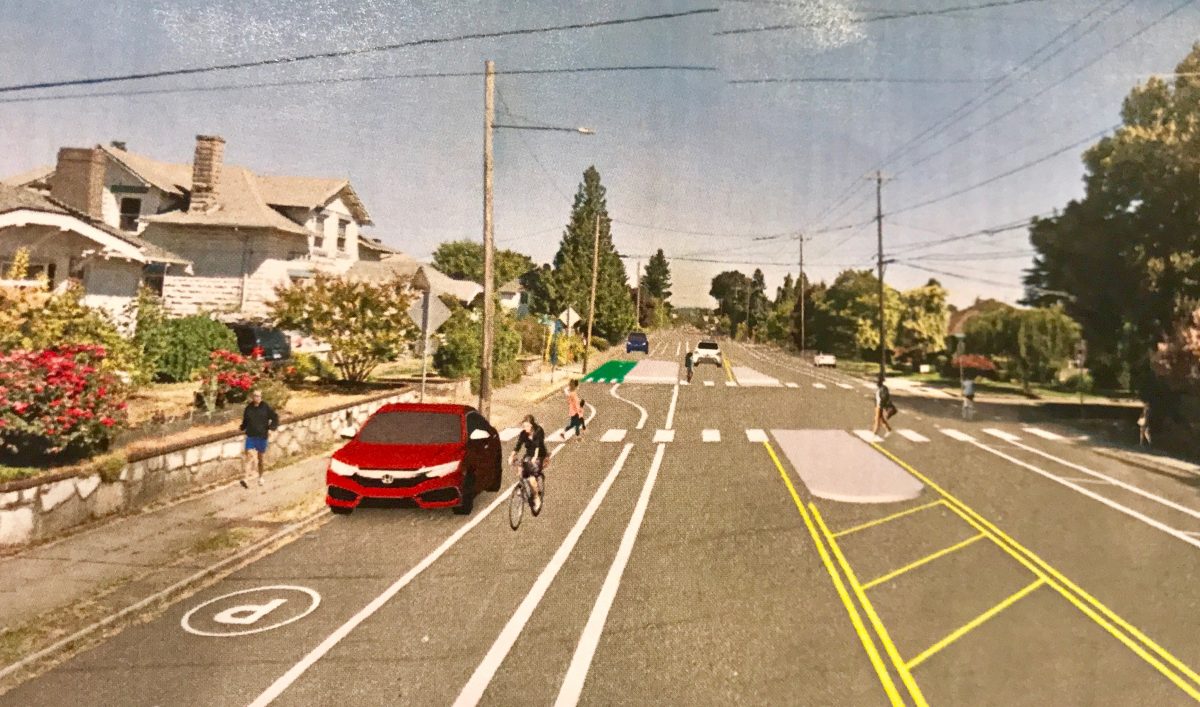
(Photo: Jonathan Maus/BikePortland)
Can we just stop beating around the bush for a second and talk about what the City of Portland Bureau of Transportation is doing to our streets?
From Southeast Foster to St. Johns, they are slowly but surely redesigning roads citywide so there’s less space for driving cars and trucks. In addition, they’re also intentionally making it harder and less efficient to drive. This is nothing to be ashamed of. In fact, it’s worth a huge celebration. If we want to make good on our potential as a great city we must move aggressively beyond the driving-alone status quo.
While it’s fun to observe PBOT’s progress from an advocacy, political, and bureaucratic perspective, I often find neighborhood meetings are the most fascinating window into the sausage-making process.
Last night I attended the Kenton Neighborhood Association meeting to learn the latest on a paving project on North Denver Avenue that will include a parking protected lane for cycling. While there, I heard an exchange between a PBOT staffer and a leader of the neighborhood association that I feel is worth sharing.
First, some background. PBOT proposed the project back in March as part of a scheduled repaving. It was supposed to be completed this summer; but PBOT now says it won’t get done until May 2019.
The initially proposed design on this short stretch of Denver (Kenton’s commercial main street) between Lombard and Watts would be similar to what PBOT just completed on Rosa Parks. Bicycle users would have a new, wider curbside lane protected from other traffic by a buffer and/or parked cars. Instead of weaving around parked cars, bicycle users would get a direct and predictable path — and it would be the auto users who would have to swerve to avoid the cars (more on that below).

Advertisement

As I mentioned in our story last week, PBOT hit pause on the project after hearing pushback from some residents. Newly-hired PBOT Project Manager Geren Shankar has mentioned several concerns that cropped up: Confusion over where to place trash cans, how the design might impact traffic, and complaints about inadequate public outreach.
At last night’s meeting, Shankar made it clear he wanted progress. “I wasn’t here then. I’m here now. And I’m trying to push the project forward.”
Shankar shared the new design that will keep auto parking on the curb and will put the bike lane adjacent to auto users with only a painted buffer between them. The initial design is also still on the table. (Note: Both options will result in fewer parking spaces; 66 fewer spaces for option 1, 35 for option 2.) Shankar said PBOT will decided on which option to build based in large part on community feedback. There’s an online survey and an open house set for October 2nd (at Kenton Firehouse) where people will get to vote on the options.
Now, about that exchange.
It was between PBOT Project Manager Scott Cohen and the Kenton Neighborhood Association Treasurer Angela Moos (who was leading the meeting in place of the absent chair). It started when Moos expressed her feelings about the initially proposed design from the perspective of a car driver:

Moos: “I would really suggest that you ask people to go down and drive Rosa Parks to get a really good feeling of how this outside-inside parking works. Because my personal opinion of that is a disaster. You’re weaving all around. It’s not a straight street anymore and it’s very easy for someone to drive right into the back of a parked car.”
Cohen: “Well, I was the project manager. There’s a reason it’s not straight. We heard from the community around Rosa Parks that they were concerned about speeds. We have data that shows the speeds are really high… 38 mph approaching Willamette Blvd is a significant hazard. The community said, ‘Help us with speed,’ so we lowered the speed limit. We couldn’t put speed bumps on it because it’s a major emergency response route. So, another thing we can do is, instead of having something that’s a wide open field for people to drive on, you can narrow the field and make them react. We’ve done this on Sandy Blvd also, where there’s kind of a natural weave to the road that keeps people paying attention so it’s not a highway. Because Rosa Parks is not a highway, it’s a neighborhood street. So, we did that with the intention of what we wanted to get out of the street — which was to give it more of a neighborhood feel so people would slow down.”
Moos: “Well it’s very dangerous. More dangerous than it was.”
Cohen: “We also have lots of data that shows protected bike lanes are much safer for all users.”
Moos: “…safer for bikers, but for people driving cars it’s hazardous.”
Cohen: “It’s safer for people to drive and walk too.”
This is PBOT not flinching when called on to defend their work. This is PBOT reclaiming our neighborhood streets from unfettered auto use. This is the PBOT we need to pull off big initiatives like Central City in Motion (and you might have noticed a similarly confident tone from a PBOT staffer in our story yesterday).
This was nowhere near the first time I’ve seen PBOT staff successfully rebut driving-centric perspectives at a neighborhood meeting; but it never gets old.
— Jonathan Maus: (503) 706-8804, @jonathan_maus on Twitter and jonathan@bikeportland.org
Never miss a story. Sign-up for the daily BP Headlines email.
BikePortland needs your support.

